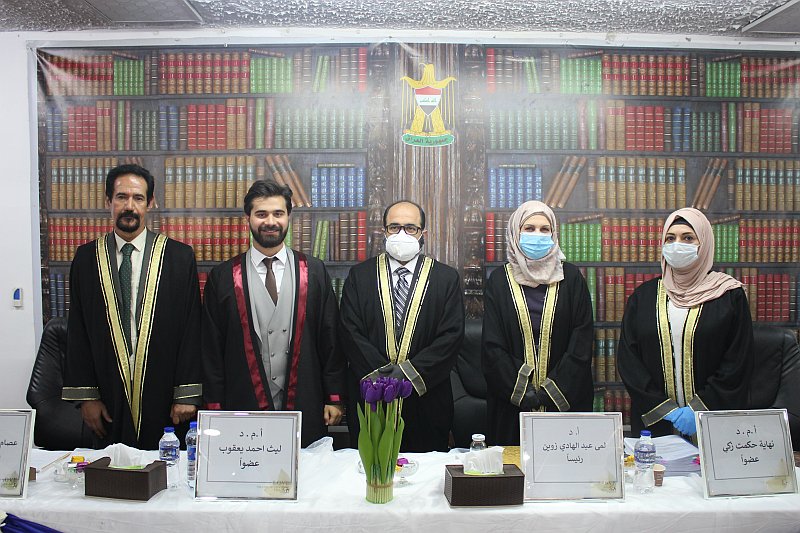ناقش قسم علوم الحياة في كلية التربية للعلوم الصرفة ( ابن الهيثم ) رسالة الماجستير الموسومة ( التخليق الحيوي لجزيئات اوكسيد المغنيسوم النانوي من بكتيريا
الكليبسيلا الرئوية المعزولة محليا ) للطالب ( حسين حيدر مظفر عبد الحميد ) التي انجزها تحت اشراف التدريسي في القسم ( أ.م.د. عصام جاسم الخليفاوي ) ونوقشت من قبل لجنة المناقشة التي تألفت من الاعضاء المدرجة اسمائهم فيما يأتي :
-
أ.د. لمى عبد الهادي زوين (رئيسا)
-
أ.م.د. ليث احمد يعقوب ( عضوا )
-
أ.م.د. نهاية حكمت زكي ( عضوا )
-
أ.م.د. عصام جاسم الخليفاوي ( عضوا ومشرفا )

هدفت الدراسة الحالية إلى دراسة تأثيرات الجسيمات النانوية لاوكسيد المغنيسيوم كمضاد للبكتيريا ومضاد لعوامل الظراوة البكتيرية ( الغشاء الحيوي /البايوفلم ) ومضاد للسرطان ، وهذا الهدف يتطلب الإجراء التالي: –
1- عزل وتشخيص بكتيريا الكليبسيلا الرئوية من عينات سريرية مختلفة واستخدام الأساليب التقليدية
(الزراعة في الوسط الانتقائي ، اختبار الكيموحيوية وجهاز vitek-2.)
2- تحديد حساسية البكتيريا اتجاه المضادات الحيوية ضد فئات متعددة من المضادات الحيوية.
3- تحديد قابلية البكتيريا على تكوين الغشاء الحيوي ( (biofilm لكل من بكتيريا السالبة لصبغة الكرام
( بكتيريا الكليبسيلا الرئوية و بكتيريا الزائفة الزنجارية ) وبكتيريا الموجبة لصبغه كرام ( بكتيريا المكورات العنقودية الذهبية المقاومة لمضاد الحيوي الاوكسيلين و الفانكومايسين ) باستخادم طريقة الألواح الدقيقة.
4- التخليق الحيوي للجسيمات النانوية أكسيد المغنيسيوم باستخدام مستخلص بكتيريا الكليبسيلا الرئوية.
5- توصيف الجسيمات النانوية لأكسيد المغنيسيوم باستخدام اجهزة الفحص ( UV-vis – X.R.D
FE-SEM- FTIR – AFM)
6- دراسة فعالية تثبيط الغشاء الحيوي للعزلات البكتيرية باستخدام الجسيمات النانوية لأكسيد المغنيسيوم.
7- دراسة التأثير السام للخلايا لجسيمات اوكسيد المغنيسيوم النانوية ضد خطوط الخلايا البشرية ( خلايا سرطان الثديMCF-7 وخلايا سرطان البروستات PC3 بطريقة فحص السمية) ( MTT assay
في هذه الدراسة ، تم الحصول على 71 عزلة من الكلبسيلا الرئوية من 144 عينة سريرية تم جمعها من فبراير الى أبريل لسنة 2019 من ستة مستشفيات في بغداد.
تم تشخيص عزلات كليبسيلا الرئوية باستخدام الاستزراع على الاوساط الزرعية الانتقائية ، شكل المستعمرات ، صبغة جرام ، الخصائص المجهرية. وأخيرا نظام فايتك -2 المدمج Vitek-2 compact system . بلغ عدد ونسبة عزلات كليبسيلا 42 عزلة (59٪) من التهاب المسالك البولية و 17 عزلة (24٪) من الدم و 4 عزلات (6٪) من البلغم و 3عزلات (4٪) من مرضى الحروق و 3 عزلات ( 4 ٪) من القيح و عزلتان (2 ٪) من عدوى الجروح.
أظهرت نتائج اختبارات الحساسية للمضادات الحيوية أن أعلى مقاومة للكلبسيلاالرئوية كانت ضد السيفوتاكسيم 52 (73 ٪) ، وأقل مقاومة للكلبسيلا الرئوية كانت ضد الليفوفلوكساسين 63 (88 ٪). أظهرت النتائج 41 (٪) مقاومة للسيفتازيديم ، 36 (٪) مقاومة للتوبراميسين ، 33 (٪) مقاومة للبيبيراسيلين ، 30 (٪) مقاومة للأزيتريونام ، 28 (٪) مقاومة لل جينتامايسين ، 12 (٪) مقاومة للسيفترياكسون ، 6 (٪) مقاومة للسيبروفلوكساسين و 5 (٪) مقاومة للليفوفلوكساسين. بالإضافة إلى ذلك ، كشفت بعض العزلات عن وجود مقاومة متوسطة ضد بعض المضادات الحيوية.
الدراسة الحالية هي الأولى التي يتم فيها تصنيع جسيمات أوكسيد المغنيسيوم النانوية عن طريق خلط راشح مزرعة الكلبسيلا الرئوية مع محلول نترات المغنيسيوم ، يتغير لون الخليط من الأصفر الفاتح إلى الأبيض ، مما يشير إلى تكون جزيئات أوكسيد المغنيسيوم النانوية MgONPs.
درست خصائص جزيئات أوكسيد المغنيسيوم النانوية MgONPs باستخدام مطياف الاشعة فوق البنفسجية المرئية UV-visible spectroscopy ، مطياف متحول فوربيه للاشعة تحت الحمراء FTIR spectroscopy ، تحليل حيود الأشعة السينية X-Ray Diffraction Analysis ، المجهر الالكتروني الماسح لمجال الانبعاث FESEM ، و مجهر القوة الذرية AMF. أظهرت نتائج التحليل الطيفي للأشعة فوق البنفسجية المرئية أن ذروة الامتصاص بلغت قيمتها )250( نانومتر مثبته وجود MgONPs. أظهر مطياف FTIR الحزم في القمم 3369 ، 2930 ، 1629 ، 1367 و 434 سم -1. القمة التي لوحظت في 434 سم ¯1 تمثل تشكيل جسيمات أوكسيد المغنيسيوم النانوية MgONPs. وقد لوحظت قمم XRD في القيم (111) ، (200) ، (220) ، (311) ، (222). تؤكد هذه النتائج أن المواد التي تم اختبارها عبارة عن جسيمات أوكسيد المغنيسيوم النانوية MgONPs وذات درجة نقاوة عالية. صورة FESEM الخاصة بـ MgONPs ، والتي تظهر بنية تشبه الرقاقات بسبب تجميع عدة آلاف من MgONPs. وقد لوحظ حجم MgONPs من قياسات تصحيح القمة لمجهر القوة الذرية AFM وتم تحديد شكل MgONPs.
أظهرت نتائج النشاط المضاد للبكتيريا لجسيمات أوكسيد المغنيسيوم النانوية MgONPs عند 100 و 200 و 400 ميكروغرام / مل كانت نشطة ضد الجرام سالبة وإيجابية الجرام. وأظهرت النتائج أن MgONPs لها نشاط مضاد للاغشية الحيوية ضد أربعة أنواع، اثنان تنتمي إلى الجراثيم السالبة جرام وأثنان تنتمي إلى الجراثيم الايجابية جرام بتركيز 200 و 400 ميكروغرام / مل.
أشارت النتائج إلى أن MgONPs تسببت في انخفاض في حيوية الخلية بطريقة تعتمد على الجرعة على كل من الخلايا MCF-7 و PC3 ، مع حساب IC50 من 76.87 ميكروغرام / مل و 136.0 ميكروغرام / مل ، على التوالي. نستنتج ان التخليق الحيوي لجزيئات أوكسيد المغنيسيوم النانوية MgONPs باستخدام راشح مزرعة الكلبسيلا الرئوية له نشاط مضاد للميكروبات ، مضاد للأغشية الحيوية ومضادة للسرطان ويمكن استخدامه كعامل علاجي.
وخلص الطالب الى التوصيات الاتية :
1- عزل وتشخيص المستخلص البكتيري واستخدام المواد الفعالة (إنزيمات ، بروتينات ، إلخ) في تحضير جزيئات أكسيد المغنيسيوم النانوية ( MgONPs )
2- دراسة التأثير التآزري لجزئيات اوكسيد المغنيسيوم النانوية ( MgONPs ) والمضادات الحيوية لتعزيز القدرة المضادات البكتيرية.
3- – دراسة فعالية تثبيط الغشاء الحيوي باستخدام الجزئيات النانوية لأوكسيد المغنيسيوم النانوية المستوى الجيني.
4- دراسة فعالية الجزئيات النانوية لأكسيد المغنيسيوم النانوية ( MgONPs ) على عوامل ظراوة اخرى مثل ( مضخات الدفق , انتاج الهيمولايسن )
5- دراسة الفعالية المضادة للسرطان لجزئيات اوكسيد المغنيسيوم النانوية ( MgONPs ) على خطوط اخرى من الخلايا السرطانية البشرية
6- دراسة النشاط السام لجزئيات اوكسيد المغنيسيوم النانوية ( MgONPs ) في الجسم الحي
BIOSYNTHYSIS OF MAGNESIUN OXIDE NANOPARTICALS FROM KLEBSIELLA PNEUMONIA LOCALLY ISOLATED
By Hussein.H.Mudhafar
Supervised by Asst.Prof. Dr. Esam j. Al-kalifawi
Objectives of the study
The present study aimed to studying the effects of magnesium Oxide Nanoparticles as antibacterial, anti-biofilm and anti-cancer agent such objective required the following procedure
. Isolation and identification of klebsiella pneumonia from different clinical samples and using traditional methods (culture on selective media, biochemical test and vitek-2 system
Determining the antibiotic susceptibility of klebsiella pneumonia isolates against multiple classes of antibiotic
. Determining the prevalence of biofilm formations for gram negative bacteria (klebsiella. Pneumoniae andPseudomonas aeruginosa) and Gram positive bacteria (Oxacillin resistance Staphylococcus aureus (ORSA) and Vancomycin resistance Staphylococcus aureus (VRSA) among the isolates using microtiter plates method
. Biosynthesis of magnesium oxide nanoparticles using k. pneumonia extract
Characterization of magnesium oxide nanoparticles using different techniques (UV-Vis, X.R.D, FE-SEM, AFM and FTIR)
. Studying the inhibition effectiveness of bacterial biofilm isolates using magnesium oxide nanoparticle
. Investigating the cytotoxic effect of magnesium oxide nanoparticles against human cell lines (MCF-7 and PC3) of oxide nanoparticles using MTT assay
Abstract
In the present study, 71 isolates of Klebsiellapneumoniae were obtained from 144 different clinical samples which are collected from February to April, 2019from six hospitals in Baghdad
Klebsiella pneumoniae isolates were diagnosed using selective media, colonial morphology, Gram staining and microscopic characteristics. Finally, diagnosed by Vitek-2 Compact system.The number and percentage of K.pneumoniaeisolates were 42(59%) isolates from urinary tract infection, 17(24%) isolates from blood, 4(6%) isolates from sputum, 3(4%) isolates from burn patients, 3(4%) isolates from pus and 2(3%) isolates from wounds infection
The Results of antibiotic sensitivity tests showed that the highest resistance of K. pneumoniae was against cefotaxim (52%), and the lowest resistance of K. pneumoniae was against levofloxacin (5%). The results showed 41 (%) resistant for ceftazidim, 36 (%) resistant for tobramycin, 33 (%) resistant for piperacilin, 30 (%) resistant for azetreonam, 28(%) resistant for gentamycin, 12 (%) resistant for ceftriaxone, 6 (%) resistant for cibrofloxacine and 5 (%) resistant for levofloxacin
The current study is the first study in which the magnesium oxide nanoparticles were synthesized by using K. pneumoniae culture filtrate with magnesium nitrate solution, the color of the mixture changed from pale yellow to white, indicating the formation of MgONPs
The MgONPs were characterized using UV-Visible analysis (UV-Vis),X-ray diffraction (XRD) analysis, Fourier Transform Infrared (FTIR) Spectroscopy Analysis, Field Emission Scanning Electron Microscope (FE-SEM), and Atomic Force Microscopy (AFM)
The results of UV-Vis spectroscopy showed that the absorption peak was at 250 nm proved the existence of MgONPs
The FTIR spectra showed bands at 3369, 2930, 1629, 1367and 434 cm. The peak observed at 434 cm represents the formation of MgONPs. The XRD peaks were observed at values (111), (200), (220), (311), and (222). These results confirm that the material tested are MgONPs with high purity
The FESEM image of MgONPs, which exhibit flakes-like structure due to the aggregation of several thousand of MgONPs. The size of MgONPs was in the range of 35–95 nm from tip-corrected AFM measurements and the shape of MgONPs were determined
The results of antibacterial activity showed that MgONPs at concentration of (100, 200 and 400) µg/ml were active against Gram negative and Gram positive bacteria
The results showed that MgONPs have antibiofilm activity against four types of bacteria, two belong to Gram negative bacteria and two for Gram positive bacteria at (200) and (400) µg/mL concentrations
The results indicated that MgONPs caused a reduction in cell viability in a dose-dependent manner on both MCF-7and PC3 cell lines, with a calculating IC50 of 76.87 µg/mL and 136.0 µg/mL respectively. It was concluded that biosynthesis of MgONPs using Klebsiella pneumoniae culture filtrate which have antibacterial, antibiofilm and anticancer activity and it can be used as therapeutic agent
RECOMMENDATION
Isolation and diagnosis of the bacterial extract and the use of active substances (enzymes , proteins, etc.) in the preparation of magnesium oxidenanoparticles
Study the synergistic effect of MgONPs and antibiotics to enhance antibacterial potential
Study the antibiofilm activity of MgONPs on genetic level
Study anti-virulence activity of MgONPs on other virulence factors such as swarming, hemolysin production and efflux pumps
Study the anticancer activity of MgONPs on other lines of cancer cells
Study the cytotoxic activity of MgONPs in vivo










